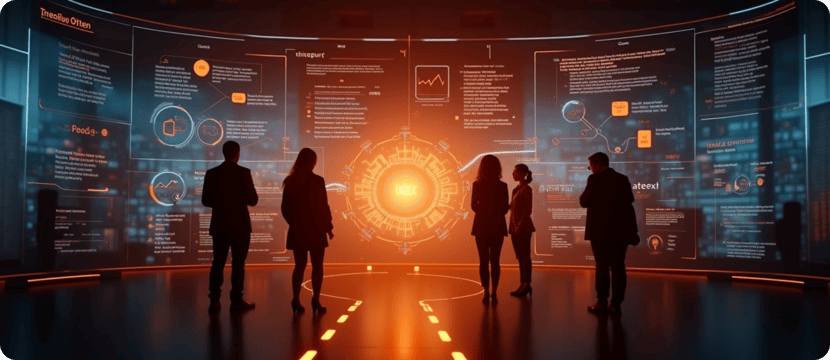

Despite being a critical cog in enterprise operations, today’s procurement departments are often riddled with legacy tools, outdated processes, and siloed data. Like an old warehouse floor that has pockets of forgotten goods and many familiar inefficiencies, traditional workflows are usually of the static kind.
But today’s GBS landscape demands a shift. No longer is it enough to treat procurement like a backroom function. Instead, enterprises must shed the warehouse mindset and adopt an approach more akin to a modern trading desk.
Using agentic AI, leading organizations are quickly transforming procurement departments into value-oriented, strategic nerve centers that are powered by intelligent agents making decisions at pace. With its capacity for end-to-end orchestration, real-time decisioning, and contextual intelligence, agentic AI offers a bold new blueprint for procurement in the modern GBS era. In fact, according to studies, 90% of enterprise leaders are actively using or planning to deploy agentic AI to optimize procurement operations.
In 2025, Procurement Functions Are Still Broken
Long viewed as a mere support function, procurement should in fact be elevated as a strategic advantage lever, but in most organizations it remains friction-heavy and fragmented. Executives are bottlenecked with siloed ERPs, decade-old workflows and inefficient processes that sprawl all across their systems. Typically, these factors mean procurement functions lack visibility into spend and supplier risks, struggle with slow approvals, and simply don’t have the agility to quickly pivot between vendors.
How then, is a CPO expected to cope with today’s levels of supply chain volatility and inflationary pressure, while simultaneously navigating a maze of regulatory changes and geopolitical instability?
The answer lies in discarding the old, rigidly linear approach to procurement in favour of intelligent, dynamic orchestration that is both adaptable, absorbs and acts on real-time data.
And that’s where agentic AI steps in.

From Assembly Line To Live Trading Desk
Legacy procurement processes were optimized for routine, predictability and static process control, but they were built for an era of steady-state operations. But today’s business environments are dynamic real-time ecosystems where supply chain shocks happen regularly and often without warning.
Agentic AI offers a solution. By deploying a network of intelligent AI agents, the technology works to semi-autonomously extract and interpret data, evaluate context and orchestrate action. It represents more than the next step in automation, entirely redefining the procurement paradigm and the results are evident. A survey by Mckinsey indicates that of enterprises that have deployed AI in procurement, 50% have seen a doubling of their ROI.
In fact, at the heart of this procurement transformation is a composable technology framework designed for agility, interoperability, and intelligence.

Enable, Elevate, Evolve: A Blueprint For Agentic AI Deployment In Procurement
The transformation of an procurement from static processes to a live trading floor where vendors, supply risks and pricing shifts are constantly updated and analysed isn’t a simple, one-off implementation. Instead, look at it as an iterative capacity build that should balance speed, strategic alignment, and scalability.
A useful deployment approach that is designed for early impact and long-term agility is this three-pillar framework: Enable, Elevate & Evolve.
Enable
Begin with well-defined, high-impact pilot programs that can be used to calibrate agent behaviour, identify priority use cases, and craft optimal agent configurations. Typical starting points could be contract intelligence analysis, supplier document triage and validation, and tail-spend optimization where AI agents can be used to flag risks, speed up vendor onboarding, and reduce low-volume and maverick spending.
From a technical perspective, this phase involves integrating agentic AI components (like multimodal ingestion pipelines, procurement-specific language models, and smart data fingerprinting) into your existing stack via API, and creating human-in-the-loop feedback cycles to better train each agent. By phasing in autonomous workflows via a measured approach, it becomes easier to build trust and attract executive suite approval as better outcomes are established.

Elevate
Once your foundational pilots have been proven to deliver value, the next step is to scale AI agents across the department, embedding them into key procurement roles. These aren’t generic AI bot, but persona-specific AI agents that are built to absorb real-time, and deliver contextually relevant results.
For example, as strategic co-pilots to category management, AI agents can quickly build optimal sourcing strategies based on a combination of internal demand data, external market trends and historical vendor performance and sentiment. Similarly, agents could also improve sourcing execution by drafting proposal templates, analyzing bids and qualifying vendors, effectively automating the end-to-end RFx lifecycle.
This stage requires building a distributed agent architecture, with role-based access controls, traceability logs, and continuous learning loops across each interaction. Workflow orchestration tools are used to coordinate hand-offs between agents and humans, ensuring explainability and override paths are always available.

Evolve
In the final deployment phase, agentic AI is institutionalized across the entire function as a core capability of the procurement ops model. Enterprises at this state are focused on optimizing value delivery by tracking AI agent performance and impact across workflows at scale, shoring up coverage, latency and training cycles as necessary.
It’s also the phase where internal agent operations teams are developed. These teams serve as ‘product owners’ across the AI workforce, and are often a combination of procurement SMEs, data scientists, platform developers, and policy leaders. Together, they manage the entire lifecycle of AI agents, from creation and compliance testing to reconfiguration and retirement.

Loved what you read?
Get practical thought leadership articles on AI and Automation delivered to your inbox


Loved what you read?
Get practical thought leadership articles on AI and Automation delivered to your inbox
Going From Volume To Strategic Value
The integration of agentic AI into enterprise procurement marks a shift away from traditional automation, where the primary focus is on achieving cost savings and higher throughput. Instead, value is created through greater trading agility, and sharper contextual decision management. Despite some technological challenges, most enterprises that have adopted agentic AI have seen a measurable improvement in ROI when using AI agents as opposed to only generative AI applications.
For CPOs, the procurement paradigm is now being reframed as a high-frequency decision engine, where agents continuously absorb signals from across the supply chain, interpret intent and context, and trigger the right workflows autonomously or in collaboration with humans. To enable this, executives must reassess KPIs, going from throughput metrics to more value-focused outcomes including risk-adjusted savings, supply network resilience, and market response agility—all to better reflect value creation in an always-on, insight-led environment where AI agents actively sense, analyze, and orchestrate decisions in real time.
Disclaimer Any opinions, findings, and conclusions or recommendations expressed in this material are those of the author(s) and do not necessarily reflect the views of the respective institutions or funding agencies.
- https://www.mckinsey.com/capabilities/growth-marketing-and-sales/our-insights/building-a-superpower-what-can-we-learn-from-the-magnificent-seven
- https://www.mckinsey.com/capabilities/growth-marketing-and-sales/our-insights/members-only-delivering-greater-value-through-loyalty-and-pricing
- https://www.businesswire.com/news/home/20241106116498/en/Ant-International-Deploys-AI-to-Streamline-and-Protect-Cross-Border-Transactions-for-Nearly-100-Million-SMEs-Worldwide
- https://www.mckinsey.com/capabilities/mckinsey-digital/our-insights/from-legacy-to-cloud-lessons-from-the-trenches
- https://www.edgeverve.com/ai-next/forrester-edgeverve-thought-leadership-paper/manufacturing/
- https://www.carriermanagement.com/news/2024/12/17/269603.htm





